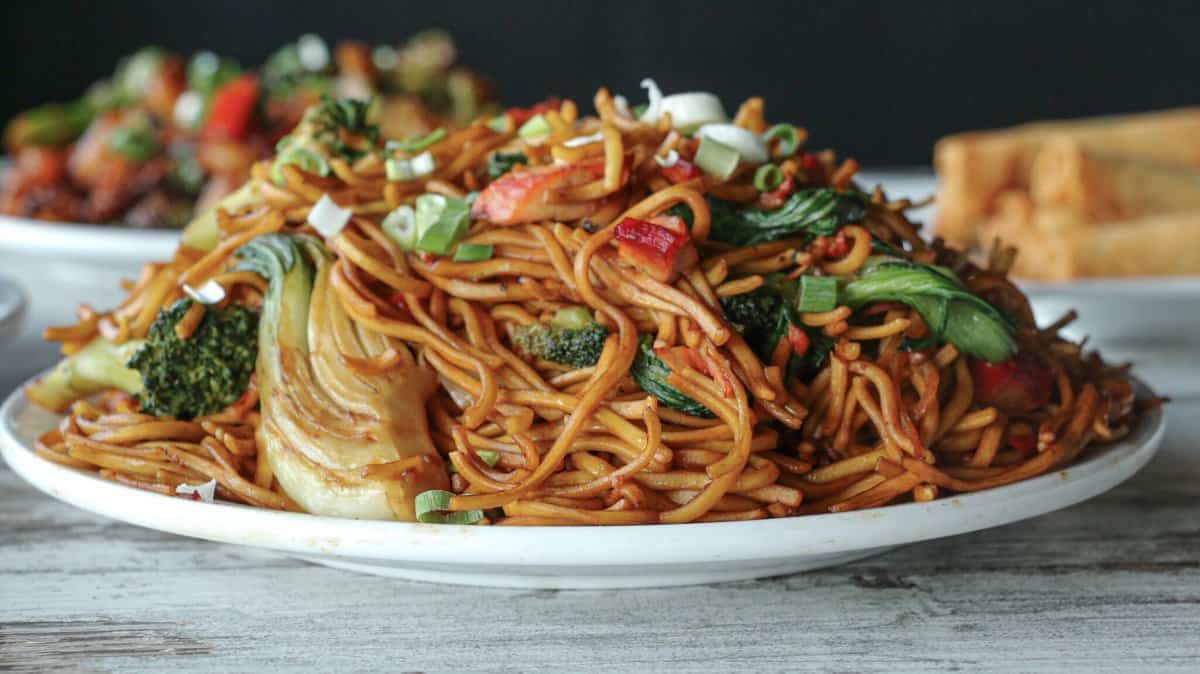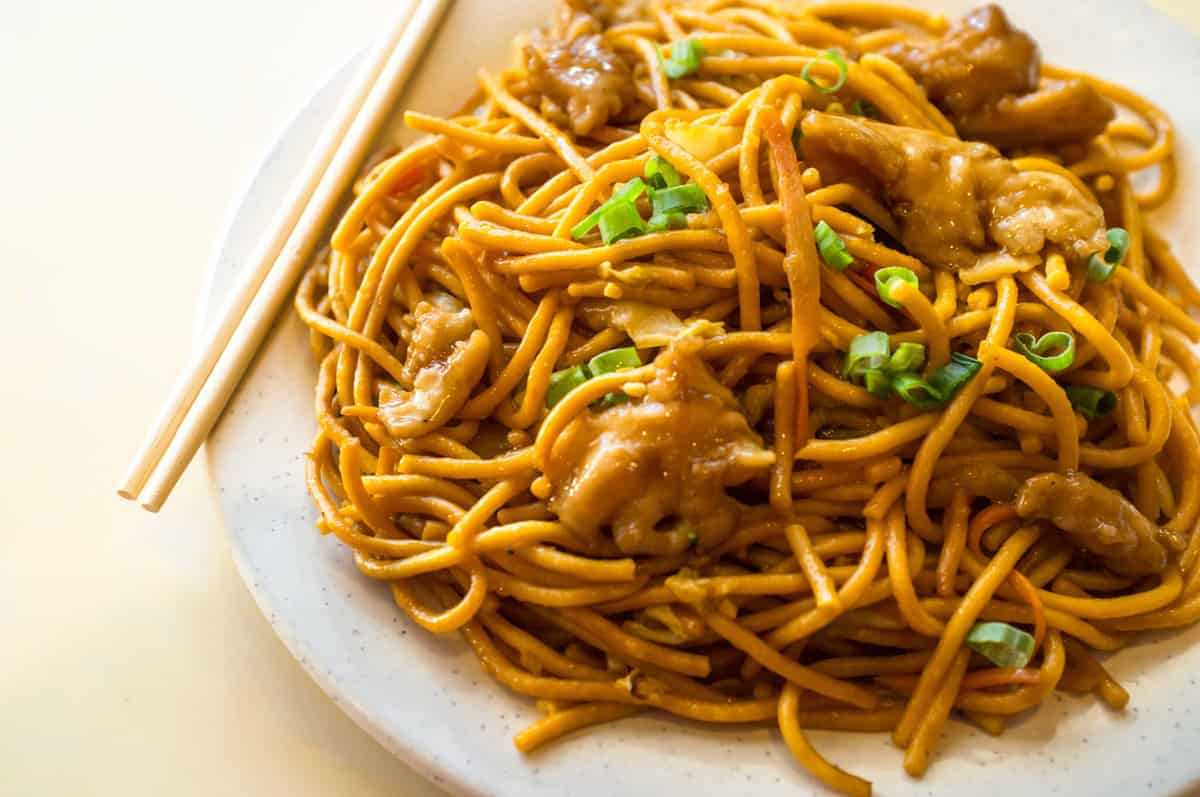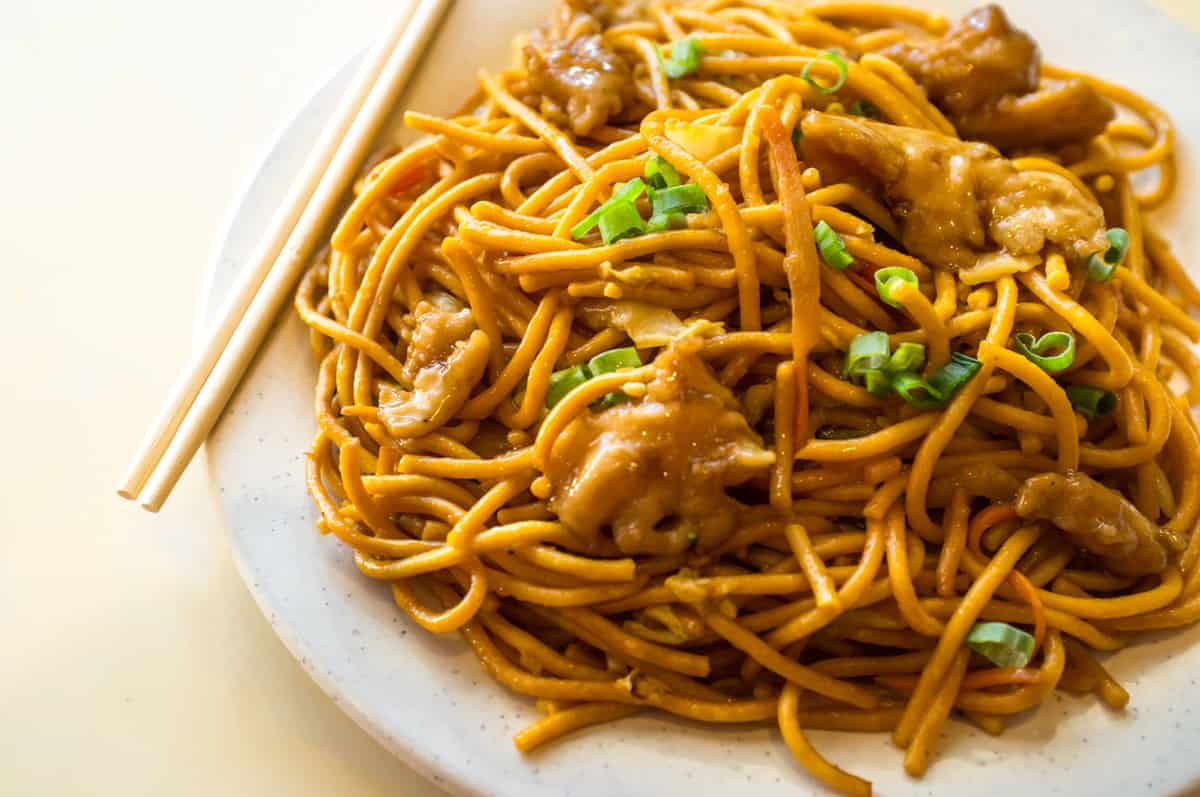It’s no secret that Chinese cooking is a firm favorite. So many people love the rich flavors, exciting vegetables, and unique preparations and textures you can get with good Chinese cooking. But, with so many options to choose from, and different restaurants and recipes calling for similar or very different ingredients, it’s sometimes hard to know how to tell one dish from a different one.
So, let’s take two family favorites, Chow Mein and Lo Mein, and talk about what makes each dish unique, how they are similar, and the core differences to pay attention to.
| Chow Mein | Lo Mein | |
| Origin | Guangdong Province, China | Guangdong Province, China |
| Cooking Style | Stir-fry | Coated in prepared sauce |
| Noodles | Thinner, slightly crunchy, noodles | Thick, chewy noodles |
What Is Chow Mein?

Chow Mein translates to mean stir-fried noodle, so almost any stir-fried noodle dish could technically be called chow mein. However, most of the time chow mein refers to a dish made with thinner, slightly firmer noodles that might even have been fried in the wok for a slightly crunchy texture.
Typically, chow mein has a drier sauce as well. This is a stir-fry that is flavorful, but a lot of the moisture gets cooked away, leaving richly flavored noodles, vegetables, and protein behind without a slick coating.
As for the vegetables and flavors in Chow Mein, it’s an incredibly versatile dish that can use just about any ingredients you have on hand with the right aromatics and seasonings.
Which makes sense, since the version of chow mein most people know in the United States and elsewhere in the Western world was brought to us by early Chinese immigrants who were figuring out how to make delicious foods that reminded them of home with a combination of traditional and non-traditional ingredients.
Different Types of Chow Mein
There aren’t a ton of different styles of chow mein, since the noodles and cooking style are the core of the dish. There are a ton of different ingredients to choose from, including different sauces and aromatics, but those are considered different recipes rather than different versions of the dish as a whole.
The two main differences come with the noodles themselves.
- Stir Fry Method: The stir fry method starts by making a pretty typical stir fry, but then adding in the par-boiled noodles a bit before the other ingredients are fully cooked, and cooking them together.
- Noodle Pancake Method: Alternatively, you can create a noodle pancake of parboiled and then fried noodles, and then pour your stir-fry over the noodles and combine.
How Do You Make Chow Mein?
Chow mein is a great dish to make at home because it’s relatively simple but with a big payoff in flavor and texture.
The key is in the stir fry. Ideally, you should make chow mein in a wok over high heat. Then, constantly stir or toss the ingredients together until you reach the perfect level of done-ness. Proteins should be completely cooked through, while vegetables should be cooked and fully coated in sauce, but still have some crunch.
For noodles, the ideal chow mein noodle texture is a matter of personal preference. Think al dente pasta, but maybe with fried bits for added crunch.
Fun Chow Mein Ingredients To Try
Chow mein can be made with almost any ingredients you have on hand, but here are a few fun options to consider: carrots, cabbage, green onion, bok choy, chicken, pork, tofu, mung bean sprouts, mushrooms (choose your favorites), ribs, spinach, zucchini.
Remember, the classic chow mein sauce is a combination of soy sauce, oyster sauce, and sesame oil, with a little cornstarch and sugar.
Chow Mein Recipes To Make At Home
Ready to try your hand at making your own chow mein? RecipeTinEats offers a fantastic chicken chow mein that goes together fast and brings a lot of flavors without too much prep time or complicated ingredients.
Prefer a vegetarian version? Substitute the oyster sauce for hoisin sauce in this delicious and colorful vegetarian chow mein from Cupful of Kale. And don’t forget side dishes! Chow mein goes well with spring rolls or egg rolls depending on your preference and the season!
What Is Lo Mein?

Lo Mein translates to stirred noodles and tends to be a chewier meal with lots of thick noodles and a richer, wetter, sauce. Like chow mein though, lo mein can have a lot of different flavors depending on the ingredients and aromatics you choose, making it an incredibly versatile dish.
Have a picky eater in your family? No problem. Just substitute in the veggies and ingredients they like for a friendly version of lo mein that offers tons of flavor and none of the tantrums.
Different Kinds Of Lo Mein
Like chow mein, there aren’t a lot of different styles of lo mein. Instead, there are different recipes for the dish and different methods of combining the noodles with the sauce and other ingredients.
- Add At The End Method: This method involves pre-cooking the noodles, then preparing your sauce, vegetables, and protein. At the very end of cooking, just before turning off the heat, add the noodles and stir to combine.
- Poured Over Top Method: Alternatively, you can make the noodles ahead, then make the sauce, vegetables, and protein, and pour the resulting combination over the cooked noodles. A large bowl is ideal, so you can thoroughly stir or toss the dish until the noodles are well-coated.
How To Make Lo Mein
Lo mein is a great option if you don’t have a wok or want a meal that you can cook over lower heat without as much stirring. The additional sauce in lo mein helps prevent ingredients from burning while cooking over lower heat is a great way to combine flavors and get a slightly mellower, more complex sauce.
All you need for great lo mein is a pot big enough for all your ingredients, and thick chewy lo mein noodles. Udon and even ramen noodles are a great substitute if you can’t find thick Chinese egg noodles in your local grocery store.
Speaking of ramen and udon, looking for more East Asian noodle dishes to add to your menu? Check out this article on the differences between Ramen and Udon, and some great starter recipes to help you make them.
Lo Mein Ingredients and Toppings
Lo mein is another dish that can be made with whatever combination of vegetables and proteins you prefer, but it is a good idea to think about what flavors you’re going for in the final dish.
A light summery lo mein might lean more on flavorful vegetables and herbs like bok choy and ginger, while your winter lo mein can be heartier with lots of mushrooms, protein, and oyster sauce for added richness and umami.
Some ingredients to consider: Carrots, cabbage, zucchini, mung bean sprouts, straw mushrooms (light), shiitake mushrooms (savory), onions, green onions, broccoli, bell peppers, or sugar snap peas.
Delicious Lo Mein Recipes To Try For Yourself
For a rich and flavorful vegetarian take on lo mein, we love this recipe from Joy Food Sunshine that will walk you through the process and deliver a brightly colored plate packed with nutrients.
Or, for a richer, more savory version, Woks of Life, has a fantastic pork lo mein recipe that combines the complex flavors of char siu with traditional vegetables.
Wrapping Up: What Are Chow Mein and Lo Mein and What Makes Them Different?
Chow mein and lo mein have a lot of similarities. Both are from Northern China and have evolved in part because of how immigrant communities adapted the traditional dishes to new ingredients and flavors after leaving China. Both have gained widespread popularity in and out of China.
Most importantly, both dishes are delicious and can easily be prepared at home and customized for your specific tastes, and even the seasonal ingredients available in your neighborhood.
- Origins: While both of these dishes come from the same province of China, Guangdong, they are unique in textures and often flavors and preparation.
- Noodles: choosing the right noodles can make or break both chow mein and lo mein. While the vegetables and proteins are the stars of the show, the noodle is the most constant texture and flavor in both dishes.
- Ingredients: if you’re looking for flexible and flavorful dishes that can be made with as many or as few ingredients as you want, both chow mein and lo mein can fit the bill.
- Sauces: chow mein is a great option if you like a drier sauce that contributes flavor, but not texture, to the meal. Lighter and crisper, chow mein packs a punch with every bite. If you love slurping up deliciously moist noodles covered in sauce, lo mein is the perfect dish.
Frequently Asked Questions (FAQs)
Q1: Which is better, chow mein or lo mein?
Largely this is a matter of personal taste since both dishes can be made to your preference. If you prefer lightly sauced noodles with some crunch and vegetables with some snap, chow mein might be the way to go. If you like a more comforting noodle with richly flavored sauce, lo mein may be the better option.
Q2: Does chow mein or lo mein have more flavor?
Neither option is inherently more flavorful, but these dishes do lend themselves better to different kinds of flavor. Chow mein is great for spicy robust flavors and is generally very savory. Lo mein can be a little more complex, with mellower but deeper flavors ranging from very light and subtle to rich and incredibly savory, but is less spicy on average.
Q3: Is chow mein or lo mein healthier?
Both of these dishes come with the problem of being a large amount of high-carb noodles in one dish and benefit from adding fewer noodles and more vegetables for a more balanced meal. However, lo mein’s larger amount of sauce can make it a fattier and more sugary meal at times.
It’s all about choosing the right ingredients, and the right balance of ingredients with these two meals.
Chow Mein vs Lo Mein
Instructions
- Choose Your Favorite Recipe
- Click the link to view the recipe
- Follow the linked instructions
- Enjoy!
The post Chow Mein Vs Lo Mein: The Differences Between These Two Classic Cantonese Dishes appeared first on Drizzle Me Skinny!.


